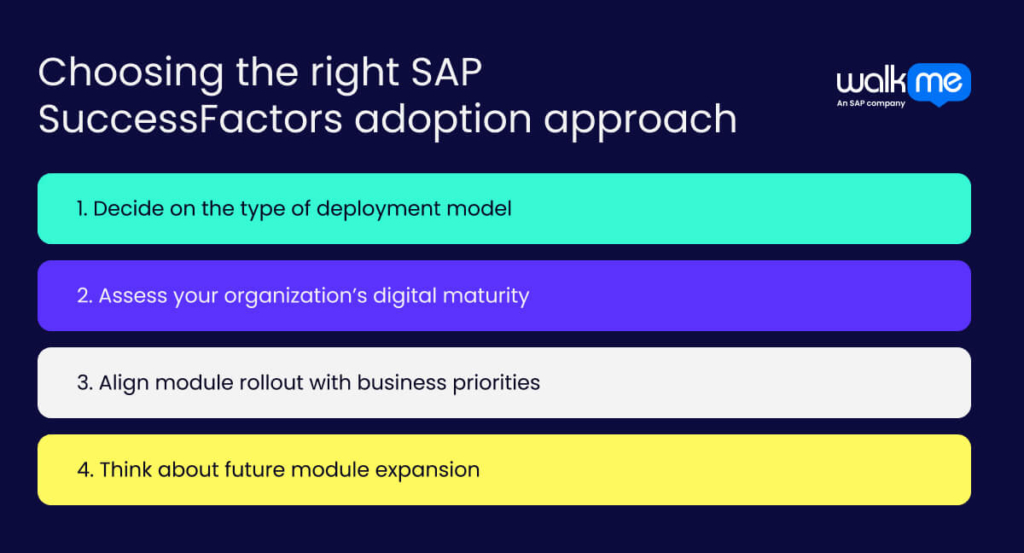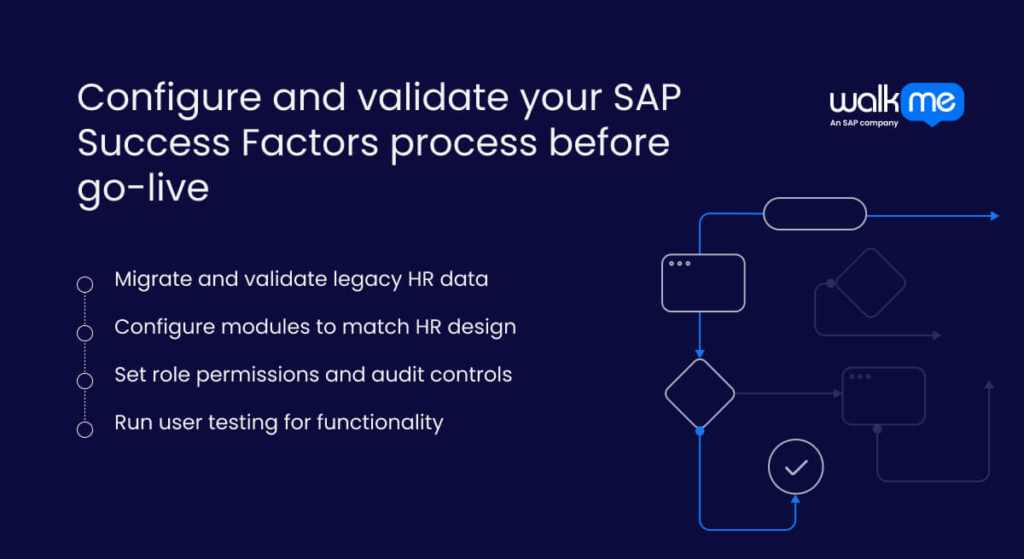Many companies utilize Human Capital Management (HCM) systems, such as SAP SuccessFactors, to enhance HR and empower their workforce.
However, installing a new system alone doesn’t ensure a successful business transformation. Real change happens when employees use the system in their daily work.
When leaders invest in SAP SuccessFactors, they must focus on user adoption to get real value. Teams need to plan for training, support, and daily use from the start.
Without preparing users, companies risk low adoption and poor results. The most successful organizations treat the go-live as the moment they begin enabling users, not the end of the project.
This guide explains what SAP SuccessFactors adoption means and how to choose the right approach. It walks through each step of the process, including planning, setup, testing, and long-term support.
What is a SAP SuccessFactors adoption?
A SAP SuccessFactors adoption is the process of using cloud-based HR tools to improve processes and enhance the employee experience. When teams actively use the system, organizations get more value from their investment.
SuccessFactors supports key HR functions like hiring, performance management, learning, and payroll. Technology adoption helps HR teams work better, manage talent, and support business growth.
Employees benefit from self-service features that give them more control over tasks like time-off requests and performance tracking. These tools improve employee retention and productivity. HR teams can also use real-time data and reports to make better decisions and plan for future workforce needs.
By adopting SuccessFactors fully, companies can shift from manual HR processes to a more strategic, data-driven approach. This transition helps address common issues such as skill gaps and resistance to change. SuccessFactors also supports compliance with changing rules, and full adoption ensures all users follow the required processes.
Choosing the right SAP SuccessFactors adoption approach

Selecting the right approach to adopt SAP SuccessFactors is crucial for a more successful digital transformation. If you choose the wrong approach, users may not utilize it effectively, and your business may miss out on the benefits.
These steps will help you make that choice:
Decide on the type of deployment model
The choice of an SAP SuccessFactors deployment model should reflect cost considerations, security requirements, and the necessary flexibility. A comprehensive cloud HCM model is well-suited for organizations with straightforward HR processes and a preference for modern, cloud-based tools.
For more complex HR environments, especially those using on-premises SAP systems, the talent hybrid model offers better integration.
Assess your organization’s digital maturity
An assessment of your organization’s digital maturity, including current technology and processes, provides a clear starting point for SAP SuccessFactors adoption. Understanding this baseline supports effective planning and ensures that each step aligns with business needs.
Informed decision-making plays a crucial role in facilitating a smoother transition and maximizing the value of the new system.
Align module rollout with business priorities
Alignment of the SAP SuccessFactors rollout with business goals begins by prioritizing the most impactful modules. A phased implementation allows for focused delivery and targeted training at each stage. This structured approach minimizes disruption and ensures that each module delivers maximum value to the organization.
Think about future module expansion
A forward-looking plan for SAP SuccessFactors adoption should account for future growth. Initial implementation typically begins with Employee Central, followed by additional modules, such as Recruiting or Learning, in later phases. A step-by-step rollout supports consistent progress while maintaining the stability of existing HR processes.
How to plan for your SAP SuccessFactors adoption process
To fully leverage the system’s value, you need to plan for the adoption of SAP SuccessFactors.
A clear plan helps manage change, handle resistance, and keep users engaged. This approach leads to stronger end-user adoption and a better return on investment. Consider these elements when planning your adoption process:
Align objectives with HR goals
In the first instance, ensure your HR goals match with business objectives. The selection of SAP SuccessFactors modules should reflect the organization’s strategic goals. Early involvement of HR, IT, and business leaders, supported by open communication, ensures better alignment.
Map your HR processes and systems
Once you are clear on your goals, map current HR processes, including workflows and data. Comparing existing processes with SAP SuccessFactors features helps identify functional gaps and determine necessary customizations. A cross-functional team, including HR, IT, and business representatives, should lead the project to ensure broad alignment.
Detail success metrics and milestones
To measure SAP SuccessFactors’ success, track both data and user feedback. Activation and adoption rates, along with login frequency and feature usage depth, offer valuable insights into user engagement.
Efficiency can be evaluated by measuring task completion times, data accuracy, and error rates. Business impact becomes clearer through metrics such as cost savings and gains in employee productivity. You can also gather feedback through surveys, interviews, and focus groups to identify areas for improvement.
Plan your data and security strategy
A robust data and security strategy for SAP SuccessFactors starts with robust access controls, effective data governance, and full regulatory compliance. The current data environment requires careful review to identify risks and gaps.
Teams should take an active role in setting policies, choosing tools, and enforcing standards. With the right foundation, the system supports secure, accurate, and compliant HR operations.
Configure and validate your SAP SuccessFactors process before go-live

Before going live, teams must configure and test SAP SuccessFactors to ensure it functions as expected.
This step helps identify issues early, prevent errors, and ensure smooth operation for users. When teams handle this upfront, this improves employee morale from the start.
Follow these steps to do this:
Migrate and validate legacy HR data
A successful migration begins with a comprehensive inventory of legacy HR data, followed by a thorough review of its quality and structure. A detailed migration plan with clear timelines can provide direction for each phase of the process.
Accurate mapping of old data fields to SAP SuccessFactors, along with error correction and format conversion, ensures data readiness. Security protocols must protect sensitive information throughout the process. Data extraction and loading should use reliable tools, followed by thorough testing and validation to resolve any mismatches.
Configure modules to match HR design
A clear map of HR processes and the data each process requires lays the groundwork for effective planning and execution. Module selection should align with business goals, with a phased rollout approach helping to deliver greater value over time.
Set role permissions and audit controls
User groups based on job role, location, or department help structure access in SAP SuccessFactors. Permission roles should reflect the tasks each group needs to perform, with proxy access enabled for testing purposes. Permission accuracy can be verified by logging in as different user types.
Audit tools, including Change Audit Reports, provide visibility into system changes and recent updates. A least-access approach ensures tighter control, supported by regular permission reviews.
Run user testing for functionality
Select a diverse group of users from various roles to ensure comprehensive coverage. It can include test types like beta testing, user acceptance testing (UAT), or usability studies.
Simple test cases, structured feedback collection through surveys or interviews, and careful review of results support continuous improvement.
Digital adoption solutions can guide users, gather in-app feedback, and track engagement. Ongoing testing and refinement help keep the system aligned with user needs.
Launch, monitor, and support post-adoption
Teams must actively manage SAP SuccessFactors after launch to ensure long-term success. This involves tracking performance, assisting users, and ensuring they utilize the system effectively in their daily work.
With the right support, users can fully leverage the system’s features. Without it, they may struggle and miss out on the benefits of the enterprise transformation. Be aware of the steps below for launch and post-adoption:
Gather feedback and spot adoption issues
Clear communication channels combined with a dedicated support team provide essential guidance for SAP SuccessFactors users. Regular surveys, interviews, and focus groups help capture user needs and uncover pain points.
Analytics focused on login activity, task completion rates, and feature utilization reveal areas where users may require additional assistance. Targeted end-user training, grounded in these insights, maintains ongoing support. Highlighting system benefits and fostering a culture of learning help create a positive mindset toward the new platform.
Track success with KPIs and impact
Success tracking for SAP SuccessFactors should focus on key metrics such as user adoption, task completion rates, and time to value. Dashboards provide a clear view of performance, with regular reporting scheduled to keep stakeholders informed.
Ongoing monitoring of user behavior and system performance supports timely adjustments to the process. Sharing success stories across teams reinforces engagement and maintains momentum throughout the adoption journey.
Offer post-launch helpdesk support
Post–go-live support for SAP SuccessFactors should include multiple help channels, such as phone, email, in-app tools, and an online portal with resources. Service level agreements (SLAs) must define resolution times to ensure consistent support.
Ongoing employee training and a well-maintained knowledge base with FAQs and guides provide additional guidance. Ticket tracking, performance monitoring, and user feedback help refine support efforts. Complex issues may require escalation to advanced support, while SAP forums offer extra assistance.
Review performance and scalability
You can assess SAP SuccessFactors adoption performance by examining improvements in workflows, data quality, and issue resolution times. User satisfaction and regular KPI reviews, combined with ongoing feedback, help identify challenges early.
Continued technical training ensures teams stay current, while a flexible approach allows for timely updates. Future growth should be supported through SuccessFactors’ cloud capabilities. A reliable implementation partner strengthens long-term success and helps maintain system performance over time.
Drive a better employee experience with SAP SuccessFactors adoption
Adopting SAP SuccessFactors is just the start of your journey. IT should take a leading role in keeping Human Experience Management (HXM) on track. This involves ensuring that systems work effectively together, guiding teams, and utilizing data to enhance the user experience.
When teams work together, the solution can grow with your business and your people. IT can help make the employee experience better over time. As a next step, review the strength of your current support model to identify gaps or explore topic clusters.
For instance, you could review areas such as integration, user adoption, and system performance to uncover specific areas for improvement. With the proper focus, SAP SuccessFactors can continue to deliver value.
FAQs
SAP SuccessFactors adoption means maximizing the value of the software by ensuring it aligns seamlessly with your HR processes and is utilized fully by your teams.
Adopting SAP SuccessFactors enables organizations to enhance HR processes, enhance employee experience, and add business value. When employees utilize the system effectively, it leads to increased efficiency, reduced costs, and enhanced engagement.
Using SAP SuccessFactors can be challenging. Common issues include moving data, handling change, connecting systems, and needing expert help. Solving these problems early is key to a smooth launch and getting the full benefits.
Adopting SAP SuccessFactors brings many benefits. It helps make HR processes faster, improves the employee experience, supports better decisions with data, and makes the company more flexible. Together, these benefits lead to increased efficiency, lower costs, and improved business outcomes.

